#minami petit cafe
Photo


Strawberry Pancakes
3K notes
·
View notes
Text
Konata Izumi Character Bio (Lucky Star)

Age: 18
Occupation: High School Student/Part-Time Waitress at a Cosplay Cafe
Family: Sojiro Izumi (father), Kanata Izumi (mother; deceased), Yuki Kobayakawa (aunt), Yui Narumi (older cousin), Yutaka Kobayakawa (younger cousin), Kiyotaka Narumi (cousin-in-law)
Likes: Anime, manga, going to Comiket, teasing Kagami, cosplaying at work, spending time with her dad, hanging out with her cousins, playing online games, arcades, curry, entering giveaways, doing anime stuff in real life.
Dislikes: Studying, reading regular books, being scolded, people who hate otaku culture, baseball season, the idea of her dad being arrested.
Voice Actress: Aya Hirano (Japanese), Wendee Lee (English)
Description
Konata is petite high school girl who is a major otaku. She loves watching anime, reading manga, and attending Comiket. Konata hangs out with her friends Kagami, Tsukasa, and Miyuki in and out of school. Konata was raised by her otaku father after her mother died when she was a baby, and has inherited his love for anime, manga and erotic games.
Personality
Konata is very laid back, lazy and carefree. Konata is a hardcore otaku, and is always collecting things related to anime and manga. When it comes to buying things that she wants, Konata is so determined to buy the items that she’s even willing to get a part-time job. Konata wishes for anime things to happen in real life, and even tries to make it happen by acting like characters from anime. Konata hardly ever gets angry or sad, but she will get frustrated if someone doesn’t understand what she’s talking about. Despite being a total troll, Konata loves her family and cares about her friends. She wants her friends to experience the joys of otaku culture. She is very close with her father and cousins.
Relationships
Sojiro Izumi: Sojiro is Konata’s otaku father. Sojiro has beeing raising Konata ever since she was a baby, as his wife had passed away not long after their daughter was born. Sojiro is an eccentric, carefree man with hardcore otaku interests. Growing up, Konata was influenced by her father and ended up as an otaku, just like him. Sojiro loves his daughter greatly, and even dreads the thought of her getting a boyfriend. Sometimes he wonders if Konata feels lonely because she doesn’t have a mom, but Konata never feels lonely since he is always there for her. He is a novelist who works at home.

Kanata Izumi: Kanata was Konata’s mother and Sojiro’s wife. She and Sojiro were childhood friends who ended up dating and getting married to each other. Kanata was a very kind woman who was used to her husband’s otaku interests, as she felt loved and safe around him. Kanata loved her daughter very much, and had hoped that she would not inherit her height or her father’s otaku personality (Konata inherited both of those anyway). When Konata was a baby, Kanata fell ill and passed away, leaving Konata to be raised by her father. Konata does not feel sad or lonely about her mother not being around, but does feel fond of her and wonders how she got her father to marry her. Kanata visited her husband and daughter as a ghost years later, and was happy to them doing so well.

Yui Narumi: Yui is Konata’s older cousin. Yui is Sojiro’s niece who works as a police officer in the traffic department. Despite being a police officer, Yui is very childlike and even irresponsible. Yui’s husband often has to travel for work, which makes Yui feel very lonely, so she often comes over to hang out with Konata. Yui is like a big sister to Konata, and she even likes to read manga like her.

Yutaka Kobayakawa: Yutaka is Konata’s younger cousin and Yui’s little sister. Yutaka is a frail and innocent girl who ends up seeing Konata as a big sister, much to Konata’s fear and surprise. She ends up getting accepted into the same school as Konata when she becomes a first year. Yutaka asks Konata questions about being a high schooler, though these questions are often about things that Konata cannot answer...like boys and how to solve math problems. Konata feels both pressure and pride when Yutaka sees her as a cool teenager.
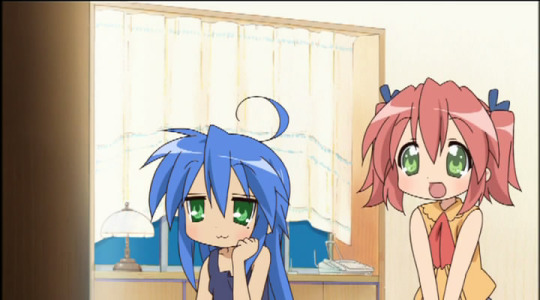
Kagami Hiiragi: Kagami is a friend of Konata’s and the older twin sister of Tsukasa. Kagami is more responsible and hardworking in school than Konata, and often scolds her when she doesn’t study. Kagami finds it difficult to understand Konata’s way of thinking, though she is sometimes impressed by. Konata loves to tease Kagami and make her feel embarrassed, such as comparing her to a rabbit or pointing out her love for snacks. Kagami hangs out with Konata because her sister, Tsukasa, is her friend and classmate, though there are moments where she does actually like to hang out with her. Kagami was dragged into going to Comiket with Konata twice. Konata calls her a ‘Tsundere’ because of her appearance and personality. Though Kagami is not an otaku like Konata, she does play more normal video games and is a secretly interested in BL manga. She has two older sisters and helps out at her family’s shrine during the holidays.

Tsukasa Hiiragi: Tsukasa is Konata’s friend and Kagami’s younger twin sister. Tsukasa more childish and naive compared to her twin sister, and does not mind Konata’s otaku lifestyle. Tsukasa is in the same class as Konata and often hangs out with her. Both Tsukasa and Konata have trouble with homework and studying, so they both often ask Kagami and their friend Miyuki for help. Konata is often impressed with how Tsukasa is good at household chores and cooking, while Kagami is not good at either of those but exceeds academically. Tsukasa went to Comiket with Konata and Kagami once...but the experience left her traumatized due to the large crowds. Tsukasa is not an otaku, but she is fascinated by Konata’s vast knowledge of anime, manga and video games. She has two more older sisters and helps out at her family’s shrine during the holidays.

Miyuki Takara: Miyuki is Konata’s classmate and one of her closest friends. Miyuki is the class representative, is very smart, and is very kind. Konata often goes to her whenever she has a difficult question, since Miyuki is a very knowledgeable person. Miyuki is not an otaku, but she does like to hang out with Konata and listen to her talk about otaku related things. Miyuki is a bit of an airhead, but Konata says that those are all ‘Moe Points’ and make her ‘a total cutie pie’. Konata is sometimes envious of Miyuki’s natural cuteness, but she does love teasing her about her curvy body. Miyuki comes from a wealthy family and sometimes does traditional Japanese activities, though her family has more of a Western lifestyle.

Nanako Kuroi: Nanako is Konata’s teacher. Nanako often tells Konata to study and gets mad if she falls asleep in class or makes excuses for not attending. Despite this, Nanako and Konata play the same RPG game together and are even on the same team in the game. Nanako even borrows video games from Konata from time to time. When Konata is playing her RPG game instead of studying, Nanako will call her out online for not studying...much to Konata’s dismay. Konata often feels sorry for her teacher during the holidays, since she seems to play RPG games instead of going out with anyone. Nanako becomes good friends with Yui through Konata, but is unaware that she is married and thinks that she is single like her.

Minami Iwasaki: Minami is a first year student and is also Yutaka’s best friend. Minami is a quiet and emotionless girl who is also a bit shy but kind. Minami and Konata only interact when Yutaka is with the two of them. Konata is the only one who notices that Minami wishes that her breasts would grow bigger, so Konata tells her that there is a ‘market for someone like her’. Konata is happy that Yutaka has a good friend like Minami. She was surprised to learn that Minami and Miyuki are childhood friends who live across from each other.

Patricia Martin: Patricia is a first year student who works at the same cosplay cafe as Konata. Patricia is a foreign exchange student who loves otaku culture like Konata. The two of them get along very well and have a lot of the same interests. Patricia is also one of Yutaka’s closest friends.
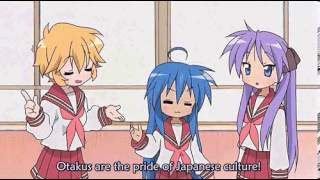
Hiyori Tamura: Hiyori is a first year and one of Yutaka’s closest friends. Hiyori draws her own manga, and often imagines Yutaka and Minami as a couple (though she often feels guilty about it). Konata and Hiyori do not interact much unless they are both with Yutaka or Patricia.

Misao Kusakabe and Ayano Minegishi: Misao and Ayano are Kagami’s classmate and also her friends. Misao and Konata do not interact much with each other, unless they are both hanging out with Kagami at the same time. Misao is actually a lot like Konata: They are like to play video games, they both hate studying, and they are both lazy tomboys. Meanwhile, Ayano is more like Tsukasa: Both are very girly and are good at cooking. Ayano does better in school than Tsukasa, though. Ayano and Konata do not interact much unless they were both with Kagami.

Minoru Shiraishi: Minoru is a background character who is the co-host of ‘Lucky Channel’ with Akira Kogami. Minoru is in Konata’s class and has minimal interactions with her. She sometimes refers to him as ‘Sebastian’, who is a butler in the anime ‘Black Butler’.

Gallery




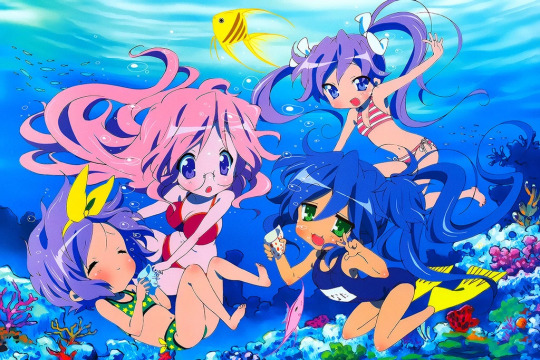





Gifs
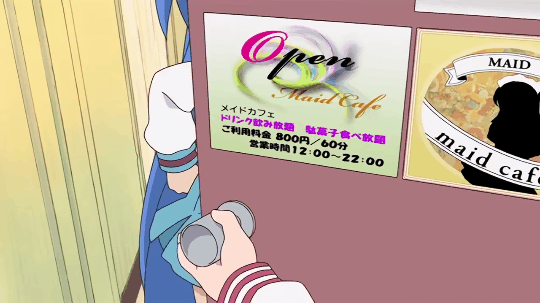






37 notes
·
View notes
Text
Celebrating Woodstock - Part 1
With the 50th anniversary of the Woodstock festival round the corner, Harsha Prabhu looks back to visiting the US for the 40th anniversary
A Fairy Tale of New York
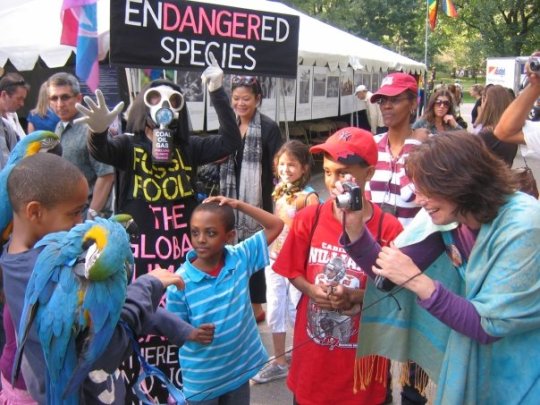
Parrots for Peace, Ecofest, Central Park, NYC, Oct 2009. Pic: Hans Lovejoy
Blog 1 on the Rainbow Dreaming US tour, covering NYC and Ecofest. Rainbow Dreaming is a photodocumentary on the alternative culture of the rainbow region of NSW, Australia. The curators were invited to set up the exhibit for the Woodstock 40th. See more at http://www.rainbowdreaming.org
Which Woodstock?
“Don’t even bother about coming to Woodstock for the festival in August,” said Nathan Koening, our host at the Woodstock Museum. “It’s mostly expensive hype. Come in October, when the weather is better and there will be more Woodstock-related events to celebrate the Woodstock legacy. And you can set up the Rainbow Dreaming exhibit.”
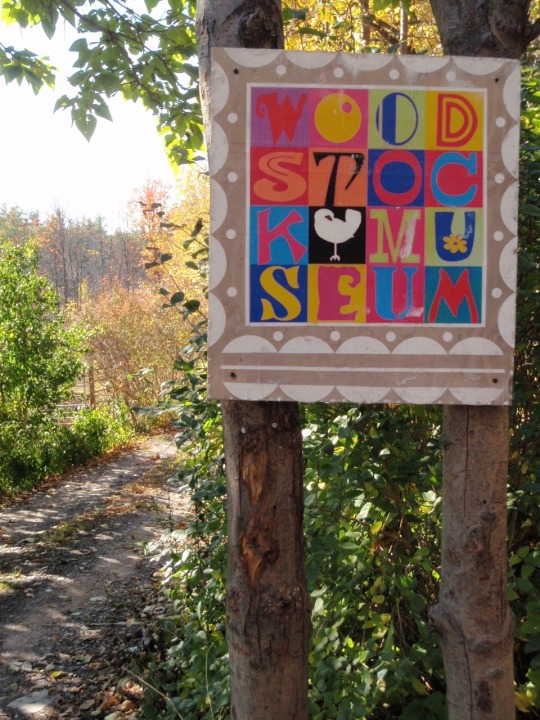
Woodstock Museum, Saugerties, NY, October 2009. Pic: Emi Iizuka
The Woodstock Museum were partners in setting up the historic Nimbin-Woodstock Connection in the mid-nineties, a rainbow bridge linking the alternative communities of Nimbin in north eastern New South Wales, Australia, with the whole hippie tradition of Woodstock. We had sealed the relationship by sending the Woodstock Museum an earlier exhibit from Nimbin, called Some Children of the Dream.
It’s now some fifteen years down the track. Walking down the main strip in Byron Bay I spy Hans Lovejoy sitting in a cafe, sipping on a latte. Hans, musician and journalist for the Byron Shire Echo, was in-between assignments.
“Fancy a trip to Woodstock?” I asked him.
“Which Woodstock?” he asked, undoubtedly knowing there were many: Woodstock, the town; the original Woodstock festival in 1969, which was held some 100 kms away; and the many, commemorative events down the years, held wherever the required permits could be obtained and the producers and sponsors lined up with the dollars.
“Not the festival,” I replied, “It’s a celebration of the Woodstock legacy.”
“Why not,” he said.
Lords of the Material Universe
The first signs were auspicious.
At Brisbane airport, waiting to catch the flight out to LA, we bumped into Elizabeth Thorpe and Debbie Lee. Elizabeth and her partner Ray, proprietors of Happy High Herbs, were the principal sponsors of Rainbow Dreaming and Lee, artist and designer, is an old connection from Nimbin. Elizabeth and Lee were headed for USA to open Happy High’s first US store, in Arizona. And Hans and myself were headed for New York, bringing with us the stories and pictures of life in the rainbow region.
From the plane, the New York nightscape glowed and flickered like some gigantic circuit board. “The lords of the material universe have nice real estate here”, said Hans. Towers of ivory, streets of gold. Would the lords be kind to us? Would they let me in, with my Indian passport?
At immigration, there was a blip: Had my passport ever been stolen? Why was it registered as Australian? The question in my head went something like: So this is what it feels to be at the mercy of dodgy databanks and the mood of the assessment officer. But it turned out ok. After a few questions, Officer Pena waived me through.
Did I have anything to declare, the customs man asked? Don’t touch my bag if you please, I have a haversack full of rainbow dreams, I mused to myself.
At the airport, the smiling face of Benny Zable, waiving a rainbow flag, greeted us. Benny, Nimbin’s ambassador to Woodstock, was the kingpin in the rainbow bridge to Woodstock and beyond. Benny had arranged for us to stay in Brooklyn, at the studio of Traci Mann, a New York tap dancer.
Disoriented by jet lag, Hans had left his laptop on the airport bus. That first night, with the El roaring past our window, we fell into a troubled sleep, woken by the clatter of the El and the cries of children at the daycare centre below.
Through a Glass
Our first pilgrimage in New York was to the Yippie Museum in Greenwich Village. The Village was the bohemian hangout par excellence in the sixties. It still has a funky, if gentrified, look. Jazz bars and restaurants dot the streets.
The Yippie Museum resembles the Nimbin Museum, with a stage for performances. One night, we caught some fine performance poetry. It’s the headquarters of New York’s hemp legalization campaign. They knew about Nimbin. They were also involved with a global linkup of cities for 2010.
1st Oct saw the launch of Mark Roselle’s book “Tree Spiker”. Mark Roselle is the founder of Rainforest Action Network. He’s also the man who infiltrated a Nevada test site. The day was also Benny’s birthday, Benny, an agent provocateur with his rainbow flags. The Yippie Museum was a happening place, true to its name of promoting green(sic) issues through direct action.
It took us a while to work out what ‘uptown’ and ‘downtown’ meant in the subway, but we had worked it out by the time we left New York!
Hans slipped out one night for a dose of jazz; the girls went on a harbour cruise; Benny was beavering away at the Ecofest office. My jet lag meant that I saw the city as if through a glass darkly. One image remains: a black, immaculately dressed saxplayer, doing “In a Sentimantl Mood” in the subway at 50th St.
Ecofest

Ecofest, Central Park, NYC, Oct 2009. Pic: Harsha Prabhu
The Ecofest office, off Broadway, was a hive of activity, presided over by Nanci Callahan, queen bee and director/producer of New York’s signature ecological fair, now in it’s 21st year.
We walked to Central Park to check out the site for this year’s Ecofest, passing Strawberry Fields and ‘Imagine’, the mosaic tribute to John Lennon. On park benches huddled New York’s homeless, shrouded in grey, under the shadows of the tall towers ringing the park. The Dakota apartments where Lennon had been shot were across the street. “Yoko Ono pays for the maintenance of this section of the park and the homeless are permitted to sleep here,” Benny explained. I thought of our homeless in Byron, chased from bus shelters, their beach humpies a mark for rangers. In this instance, New York seemed to have a heart.
Sunday 4th Oct was a fine day. The Ecofest site began to fill up with vedors and exhibitors, including the latest hybrid cars from Toyota and Ford.
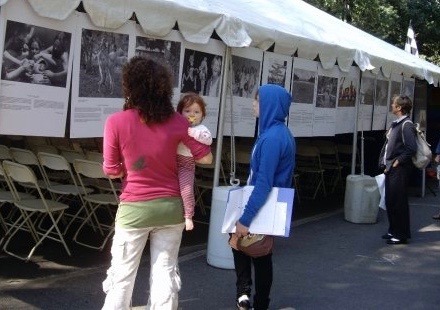
Rainbow Dreaming at Ecofest, Central Park, NYC, Oct 2009. Pic: Harsha Prabhu
We had been assigned the outer wall of the conference tent to set up the Rainbow Dreaming exhibit. Space restrictions meant only half the exhibit could be accommodated. We punched holes into the exhibition panels and strung them out on twine like washing on a line. It worked! Sayaka Nakao, Rina Terasaki and Saya Minami, our Japanese friends from Byron Bay, who had flown in the previous day via Tokyo to help with the exhibition tour, assisted us in this improvisatory task. Ever enthusiastic, our petite helpers were worth their weight in gold. Hans and I would have struggled to manage the show on our own.
Over 25,000 visitors streamed through Ecofest that day and, as we were positioned at the entrance, many of these stopped by to check the exhibit. Among these was Nirmala, Gina Lakosta’s daughter, who was in New York to perform a burlesque show, under the stage name La Viola Vixen. Another was a couple from Goonengerry, amazed to stumble upon a slice of life from the rainbow region in the heart of New York.
Tap dancers, including the amazing Mabel Lee, Traci Manns’s former teacher, all of 80; soul singers; stiletto heeled models strutting eco fashions; Rick Ulfik from We the World, the global peace network; Parrots for Peace from the Amazon rainforest; ending with a sing along with the legendary Pete Seeger, 90 years old and still singing his peace and environmental anthems.
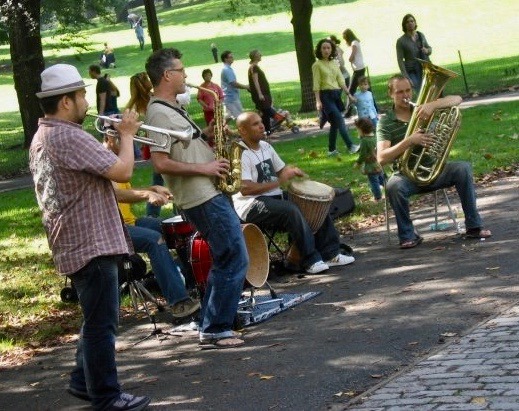
Jam session, Central Park, NYC, Oct 2009. Pic: Harsha Prabhu
The sun shone down on Benny Zable’s rainbow flags; children fed ducks in the pond; whole families happily picnicked under the trees; frisbees flew in the air. Catching the last of the sunset, the tall towers seemed to shower us with riches and green fields became fields of gold.
The evening ended with drumming. Three drum circles – Cuban, Haitian and African – rang out in the Park. The moon was full and so were our hearts.
Postscript: Hans’ laptop, lost on our first night, was returned to him by the New York City Transport Authority on our last morning in New York, in a fairy tale ending to our stay in the Big Apple!
Van Gets Ripped, or The Long Sleep of Unreason
Blog 2 on the Rainbow Dreaming US tour, taking in New York’s 13th Harvest Festival & Freedom Rally, Hancock, NY; and Woodstock Museum, Saugerties, NY.

Ma & Pa Woodstock, NY Harvest Fest & Freedom Rally, Camp Minglewood, Hancock, October 2009. Pic: Harsha Prabhu
New York Harvest Fest & Freedom Rally
Marijuana legalisation activists and their supporters on the East coast were to meet at Camp Minglewood in the Catskills, a couple of hours north of New York, for the Harvest Festival & Freedom Rally, on 9 Oct.
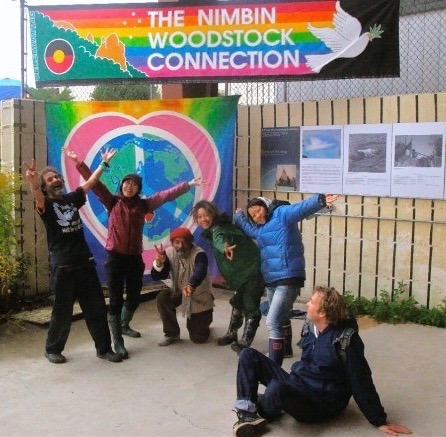
Rainbow Dreaming crew at New York Harvest Fest & Freedom Rally, October 2009
It was an opportunity too good to be missed. Our hosts from the Woodstock Museum, Shelli Lipton and Nathan Koenig, had booked us a spot at the Festival. They had also booked us into a bunkhouse, with 10 bunk beds. By now we had mushroomed to a party of 10.
It wasn’t pot, but potties that preoccupied us the three days we were there. The toilets were blocked. Much time and energy was spent agonizing over the situation and negotiating the portaloos well before the happy horde that had descended on the Camp trashed them every morning.
Harvest Fest, the child of Hemp activist and performance poet Rob Robinson, was now in its thirteenth year. The legal situation with pot in the US is complex and confusing. Some states (California) allow the medical use of marijuana. Others will bust you for possessing rolling papers. The talk at the Camp was all about the bust of a long-time hemp activist, who had been caught with a whole lot of pot that he was bringing to the festival. Regardless, the pot was plentiful.

Camp Minglewood, Hancock, October 2009. Pic: Harsha Prabhu
From pot to politics. I met Kurt Shotko, a member of the Greens party. Kurt was of the opinion that the Republicans and Democrats were cut from the same cloth, manufactured by big business. “Look at what Obama’s doing in Afghanistan. He’s sending more Americans to die there. We need an alternative to the main players. We’ve got to wake up to the reality that the American dream has been a nightmare for a lot of Americans and for the rest of the world, especially in Iraq and Afghanistan. We have been asleep for too long. We need a revival of common sense. Only a massive program of self education is going to do it.”
Then he quoted from the Populist Program, published in 1892: “They propose to sacrifice our homes, lives and children on the altar of mammon; to destroy the multitude in order to secure corruption funds for the millionaires.”
1892! The sleep of unreason had been a long one.
But Kurt was hopeful of the next generation. That’s why he set up camp at festivals across the US. And that’s partly why we were there too.

Benny Zable in front of archival pic from Rainbow Dreaming, NY Harvest Fest & Freedom Rally, Camp Minglewood, Hancock, October 2009. Pic: Harsha Prabhu
The Rainbow Dreaming exhibit was attached to a wall in the main music hall. Thus many, mostly young, punters got to see the exhibit. This was where The Wailers played on Saturday. I caught the Wailers when they played in Byron and I’m happy to report that they are still wailing away.
But what struck me most about the music at Harvest Fest was the pervasive influence of the Grateful Dead, the legendary sixties psychedelic band from San Francisco. From Cabinet, an established US indi band that played the main stage, to camp fire songs at 4 am, the Dead were everywhere, on so many t shirts and stickers, in so many riffs and improvisatory moments, as a psychedelic glint in so many eyes.

George Clinton & Funkedelic, NY Harvest Fest & Freedom Rally, Camp Minglewood, Hancock, October 2009. Pic: Harsha Prabhu
I spoke with Jane, an artist from New York, who had a stall selling Dead memorabilia. She had grown up in San Francisco and was still a Deadhead. Her eyes misted when she spoke of Jerry Garcia: “You could see so much love pouring out of him. It was a love affair that lasted and lasted and it’s still going strong even when he’s gone.”
Minglewood Moment: across from the festival site, two lovers sit on the steps of a boat ramp. The dying sun paints purple tints on the tops of the maple and elm; waterfowl break the surface of the lake. A band is playing the Dead’s “China Cat Sunflower.”
Woodstock: The Town that Time Forgot
In Rip Van Winkle, Washington Irving’s story, a man who wanders off into the Catskill Mountains, meets some rather strange companions who serve up a suspiciously heady brew, and falls asleep under a tree. When he wakes up, he finds that some 20 years have gone by and his world has changed.
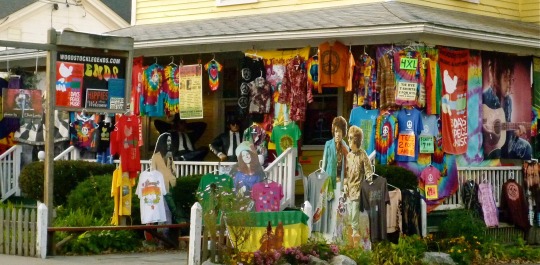
Woodstoock, October 2009. Pic: Harsha Prabhu
The town of Catskill is 30 minutes away from Woodstock. Some 40 years have gone by after the infamous Woodstock festival of 1969. And the world has changed since those heady days. But walking around Woodstock, the town that gave a name to the festival, (which happened in the neighbouring town of Bethel, some 100 kms away), you could be forgiven for believing that it’s still in the thrall of those halcyon days of hippiedom.
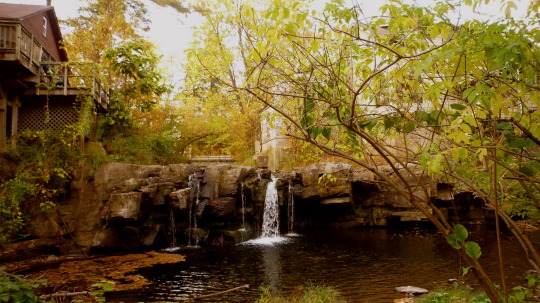
Woodstoock, October 2009. Pic: Emi iizuka
Our first port of call was the Woodstock Town Board meeting that night. Benny Zable, Nimbin’s ambassador to Woodstock, presented letters from Nimbin and the crew made a presentation on the Rainbow Dreaming exhibit and its relevance to the whole Woodstock legacy.
The meet was dominated by a spirited discussion over rezoning issues, something very familiar to us on the north coast. Would Woodstock go the way of other small towns and be besieged by rampant development, or would it stay true to its alternative legacy?
That night we also visited the Bearsville Cultural Centre (set up by Albert Grossman, one-time manager of Bob Dylan, Janis Joplin and The Band) and Alchemia Café to catch some live music, including a spirited set by Adam, a young musician we had met at the Byron market drum circle!
Guided around by Benny, on our very first day in Woodstock, we met some representatives of Woodstock’s hippie past: Jogger John, the local village savant, who used to jog everywhere, but, due to his advanced age is now is on a bike; Day A, the village barber, who runs a soup kitchen for the Rainbow Family in town; Grandpa and Grandma Woodstock, an elderly couple, dressed the part, almost town mascots. Woodstock itself is full of funky cafes and art galleries. Turn a corner and spy a Zen garden, complete with waterfall and pergola.

Peace Pole, Woodstock, October 2009. Pic: Emi Iizuka
In the centre of Woodstock town is the village green and the peace pole, with peace messages in several languages. We bumped into Fr John, a priest and peace activist. When he heard that two of our crew, Sayaka Nakao and Rina Terasaki, were from Tokyo, he beamed at them and said: “ Let’s set up a peace link between Woodstock and Tokyo. All it takes is five people. Five is the magic number. Can you find five friends in Tokyo who may be interested?”

Hippie Church, Woodstock, October 2009. Pic: Harsha Prabhu
Fr John also runs the Hippie Church, on the hill overlooking Woodstock. This was the very church where Bob Dylan was rumoured to have married the love of his life, Sarah, his sad eyed lady of the lowlands. The church wears the patina of age, its icons fading in the dim, dank light streaming through stained glass windows.

Path to Buddhist monastery, Woodstock, October 2009. Pic: Harsha Prabhu
In stark contrast is the Buddhist monastery next door. Set up in 1975, the monastery is linked to the 10th century Tibetan Kagyu lineage. Its halls are huge and lushly decorated with tankas, its massive Buddha is gold-painted, its prayer lamps cast a beatific glow on meditating monks and visitors; its gift shop bulges with merchandise, all a tribute to Buddhism’s growing influence in the new world.
Prophesy
The next morning, my very first snowflakes, fine and feathery.
It was too cold to venture out. Emi Iizuka and Simeon Michaels, both from Byron, had joined us in Woodstock. We were toasty warm at the Woodstock Museum, hosted by Shelli and Nathan.
Under the tutelage of Shelli, the sacred Indian corn was brought out and inspected. Purple, yellow, orange, red and black, this was authentic Hopi corn. The girls played with the corn silk, good for medicinal tea and dress ups, fake moustaches and beards. They were transformed into imaginary characters, magical beings, the warrior princesses of Genghis Khan, dressed as men to pass unnoticed amidst the ripening corn. Shelli makes beautiful corn necklaces, a craft she learnt from Rainbow Weaver, a Mohawk Clan Mother.

Padmasambhava, Buddhist monastery, Woodstock, October 2009. Pic: Emi Iizuka
Nathan spoke about the connection between the Hopi and the Tibetans. “Padmasambhava, the founder of Tibetan Buddhism, said: When the iron bird flies and the horses run on wheels the Tibetans will be scattered over the face of the earth and the dharma will come to the land of the red man.”
Nathan went on: “The Hopi’s felt that this might have something to do with the dharma coming to the US. They have prophesies too. After the swastika and the sun, there would be another force, symbolized by the colour red. This force will wear a red cloak or red cap. Spiritual wisdom will come from the East. This spirituality must spread. If that does not take root, others with the red symbol will invade from the West and crawl over the land in one day. The Hopis think this could be the ‘red’ Chinese.”
“When the Tibetan Karmapa visited Hopiland in 1974, he said: We must have know each other before; your features, ceremonies and way of life are similar to our own. When we bought Hopis to the monastery in Woodstock in 1979, the two cultures again recognized each other, and the Hopis said that the Tibetans may very well be the long lost brother who left them at the beginning of time and went to the other side of the earth to balance the earth spiritually.”
Said Shelli: “When the shit hits the fan, we won’t survive unless we cooperate with each other. That’s also what the Hopi prophecies speak of. The Hopis are known as the ‘peaceful ones’.”
While we spoke of prophecies, outside, in the gathering gloom, Tiago Guimaraes, a Brazilian artist, was busy carving out a statue of a man with a guitar, the quintessential hippie hitchhiker, his hand raised, his fingers flashing the peace sign.
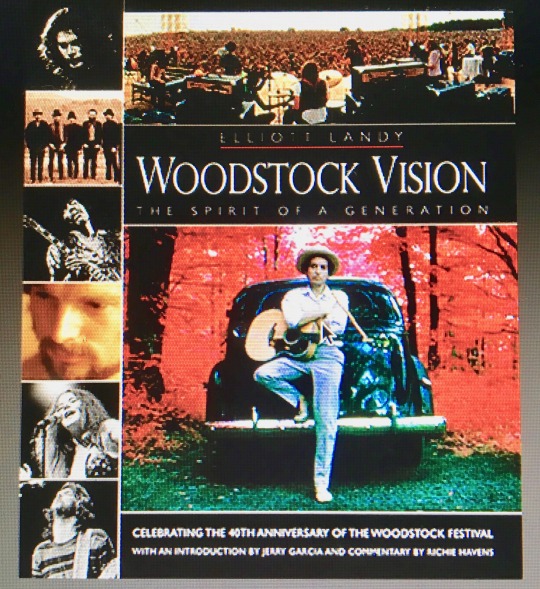
Elliot Landy’s book on Woodstock
The Rainbow Dreaming opening at the Woodstock Museum on Sat 17 Oct was a modest yet sweet affair: local musos were in attendance and we joined the members of the Woodstock drum circle in a bongothon.
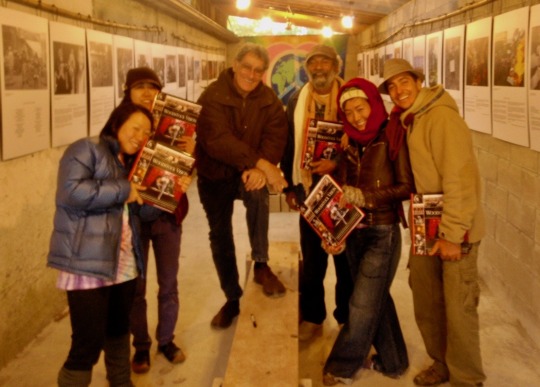
Rainbow Dreaming crew with Elliot Landy, Woodstock Museum, October 2009. Pic: Hans Lovejoy
The highlight of the evening was meeting Elliot Landy, the famous Woodstock photographer. Elliot was all praise for the exhibit, gave away signed copies of his book to all the crew and offered to help us find a publisher for a book on the exhibition. (Sadly, I was to leave my copy on the street in San Francisco while moving house.)
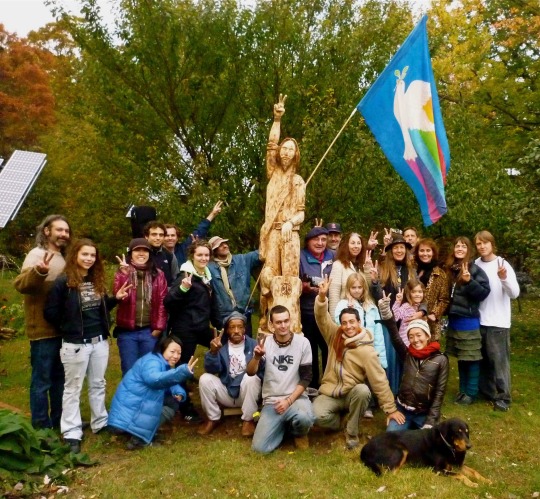
The Last Hippie, Woodstock Museum, October 2009. Pic: Harsha Prabhu
The last act of the day was raising the sculpture of the hippie hitchhiker and placing him on his pedestal: a symbol of Woodstock’s hippie past and a pointer to its uncertain future as a cultural pilgrimage centre.

Woodstock Earth, after the drum circle, October, 2009. Pic: Simeon Michaels
On our last evening in Woodstock, we participated in the Woodstock Earth drum circle. Some 30 drummers were gathered in the backyard at Day A’s house. In summer, the drummers gather at the village green and spill out onto the road. As the sound of the drums rose over the autumn dusk, we were again reminded of how lucky we were with our vibrant culture of communal drumming and dancing in the rainbow region.
Last days in New York: the Bangladeshi cigarette sellers; the African rickshaw pullers in Central Park; the old men and women carting large bundles of recyclable cans and bottles; the man in Times Square offering to sell me a 15 carat gold ring or Obama condoms.
While the crew went shopping and sightseeing I wandered back to Central Park. More than the statue of Liberty, than Ground Zero, than the suicide gulches and canyons of Wall Street, I was drawn to the spot with the Imagine mosaic and tribute to John Lennon. Park benches line the walkway, each with its dedication. I sat there, amidst the touros and derros, as the shadows lengthened.
Then I saw these lines from Dylan Thomas, carved on a park bench: “Though lovers be lost love shall not; And death shall have no dominion.”
Celebrating Woodstock - Part 2 on San Francisco’s Westfest and the Beats to follow. Please check my blog...
by Harsha Prabhu

Rainbow Dreaming crew at Magic Mountain, Woodstock, October 2009
NOTE:
An edited version of A Fairy Tale of New York was published in the Byron Shire Echo, October 2009.
While the words and sentiments in the blogs are my own, this project has been a community cultural initiative, helped along by many hands, hearts and minds. Many thanks are due.
First up, Benny Zable, Shelli Lipton & Nathan Koening for setting up the Nimbin Woodstock Connection and the sister village link between the two communities.
I would like to acknowledge the help and guidance offered by the Rainbow Dreaming crew – Benny Zable, Hans Lovejoy, Saya Minami, Sayaka Nakao, Rina Terasaki, Emi Iizuka & Simeon Michaels – on this amazing journey to the US.
Thanks to our hosts in the US, including Traci Mann & Nanci Callahan in NYC; Rob Robinson at Harvestfest; Shelli Lipton & Nathan Koenig at Woodstock Museum; and Douglas Kolberg & Boots Hughston at Westfest.
Thanks to our principal sponsor Happy High Herbs and our media sponsors Byron Shire Echo & Bay FM.
Thanks to all those who donated to the community chest to make this project possible, including all the artist and performers from the rainbow region who helped raise funds for the US tour.
And a big thank you to all the freaky people of the rainbow region, who are the inspiration for this project. And the writers and photographers who so generously donated their work.
This project was auspiced by Byron Community & Cultural Centre, assisted by Lismore Regional Gallery and supported by Byron Neighbourhood Resource Centre and Mullumbimby & District Neighbourhood Centre.
Rainbow Dreaming was curated & produced by Harsha Prabhu & Graeme Batterbury for the Rainbow Collective.
More on Rainbow Dreaming, including how to get a copy of the book, at: www.rainbowdreaming.org
#woodstock#woodstock festival#newyork#woodstockmuseum#nimbin#byronbay#photography#hopi#rainbowregion#padmasambhava#ecofest#cannabislawreform#elliotlandy#hemp#woodstockanniversary
3 notes
·
View notes
Text
Hotel Congress Never Ending Minami Kanto Tour 2019
Hotel Congress ネバーエンディング南関東ツアー 2019
Jan/16 Troubadour, Tama Plaza
Jan/17 Cafe Goatee, Kamakura
Jan/26 Bar Derek and The Dominos, Shinmaruko
Feb/16 Surfers, Zushi
Feb/17 Univibe, Kamakura
Feb/23 Bar Derek and the Dominos
Mar/21 Bar RAM, Kamakura
Mar/26 HANA, Matsumoto - opening for Toshirow Higurashi
Mar/30 Bar Derek and the Dominos
Apr/13 Bar Derek and the Dominos
May/11 Bar Derek and the Dominos
May/12 Kamakura Petit Rock Festival
June/9 Univibe Kamakura
June/22 Bar Derek and the Dominos
July/20 Bar Derek and the Dominos
Aug/23 Cherokee, Gakugei Daigaku
Aug/24 Bar Derek and the Dominos w/Hitomi Yoshimura
Aug/31 Zaimokuza D3, Summer End Harmony
Sep/20 Bar RAM, Kamakura
Sep/21 Nishiyokohama El Puente, Born To Booze Vol.15
Sep/28 Bar Derek and the Dominos
Oct/26 Bar Derek and the Dominos
2 notes
·
View notes
Text
New Post on Actualités
Nouveau post sur http://www.blogpresso.com/kyoto-et-nara-youmakefashion/
KYOTO ET NARA – youMAKEfashion
youtube
En partant 10 jours seulement au Japon nous savions qu’il serait impossible de sillonner le pays. Mais pour comprendre un temps soit peu ce pays nous voulions visiter au moins une seconde ville (si ce n’est deux). Nous avons ainsi passé quelques jours à Kyoto et découvert Nara par la même occasion. Nous savions que Kyoto était très touristique mais nous voulions voir le japon plus traditionnel. Nous avons pris le train, comptez 2h30 de trajet.
Sur Airbnb nous avons réservé un ryokan. Une « auberge » typique japonaise.
Je partage avec vous le lien car tout était parfait, l’accueil de l’hôte était très touchant et en plus le ryokan était bien placé (des vélos étaient à disposition c’était super pratique) :
-35€ en vous inscrivant sur Airbnb via CE LIEN. Inscrivez-vous, 35€ de réduction vous attendent et seront appliqués sur votre première réservation, quelque part dans le monde.
L’entrée se faisait dernière un temple tenu par le fils de la propriétaire du ryokan. Après avoir laissé ses chaussures à l’entrée il suffisait de monter à l’étage pour découvrir l’unique pièce séparée par des portes coulissantes en papier et en bois. Dans un style plus que minimaliste nous avons dormi sur un futon. On a adoré !
PONTOCHO
Premier soir direction la rue piétonne Pontocho. La rue est parallèle à la rivière kamo que vous pouvez longer pour une balade avant de dîner. Un choix immense s’offre à vous dans cette rue touristique mais géniale. Nous avons par hasard misé sur un petit restaurant qui proposait une fondue japonaise au yuzu. Légumes, poissons, viandes, nouilles… nous avons tout fait cuire nous-mêmes dans un bouillon citronné. Un délice ! Je vous conseille cette adresse.
YUZUGEN
212 Nabeyamachi, Pontocho Shijo-dori Agaru, Nakagyo-ku, Kyoto 604-8015 Kyoto Prefecture
Faites bien attention aux horaires, les japonais mangent très tôt, les restaurants ferment entre 21h et 22h.
Tellement de temples à visiter, de sites à découvrir… il a fallu faire des choix.
Vérifiez bien les horaires également, les parcs et les temples peuvent fermer tôt.
KINKAKU JI (pavillon d’or)
Pour chaque visite il est conseillé d’y être tôt. Alors vous serez plus tranquilles lors de votre première visite matinale et un peu moins le reste de la journée.
Nous avons commencé ce matin- là par Kinkaku Ji (que nous avons atteint en bus). Nous y étions à 8h30 pour l’ouverture. Un temple bouddhiste recouvert de feuilles d’or qui se reflète dans l’eau de son beau jardin.
Comptez 400¥ l’entrée par personne
GINKAKU JI (Pavillon d’argent)
Après avoir récupéré les vélos prêtés au Ryokan nous avons filé au pavillon d’argent (6km tellement agréables en vélo, même si parfois ça grimpe aussi).
La matinée ayant bien débuté il y avait davantage de monde (nous étions en plein milieu de la golden week, LA semaine de vacances pour les japonais donc il faillait s’y attendre).
Le temple était lui aussi superbe mais j’ai surtout été fascinée par le jardin du pavillon d’argent. Une nature riche, un entretien pensé au millimètre près (j’ai aperçu des gens dépoussiérer les arbres et balayer la mousse) et une ambiance si zen…
J’ai moins aimé visiter ce circuit bien défini à la queue leu leu avec des centaines d’autres touristes mais pendant ce séjour à Kyoto il a fallu faire avec pour profiter de ces merveilles malgré tout.
Comptez 500¥ l’entrée par personne
TETSUGAKU NO MICHI (promenade des philosophes)
Toujours en vélo (mais très sympa à faire à pied également) nous avons longé la promenade des philosophes. La balade se fait le long du canal, à l’abri des arbres (surtout des cerisiers), c’est un moment très paisible.
HONEN IN
À tout moment il est possible de bifurquer et visiter un des nombreux temples autour de cette promenade.
Nous avons entre autre découvert Honen in, un petit temple caché dans la forêt et bien plus calme.
GION
Retour en vélo direction Gion. Un quartier où nous comptions dîner mais que nous voulions voir aussi de jour.
Nous avons déjeuné en plein cœur du quartier chez Gino tanto. Comme souvent nous nous sommes aventurés au hasard dans un restaurant qui s’est avéré délicieux avec une terrasse atypique qui donnait sur Shirakawa-Minami dori.
Nous avons commandé des okonomiyaki que nous avons dégustés directement sur une plaque chauffante au centre de notre table. Ici vous mangez assis au sol avec vue sur les cuisines. Génial!
On s’est ensuite balladés dans Gion pour digérer 😉 De superbes petites rues à découvrir comme Shirakawa-Minami dori et ses alentours.
FUSHIMI INARI TAISHA
En vélo nous avons rejoint la gare la plus proche pour prendre le train pour Fushimi Inari Taisha.
4km de portes couleur vermillon. Des milliers de torii qui sont des dons, les écritures sont d’ailleurs les noms des généreux donateurs.
En arrivant vous risquez d’être impressionnés par le monde mais plus ça monte et plus les gens rebroussent chemin. On enfile de bonnes chaussures ce jour-là et on grimpe découvrir cet incroyable sanctuaire.
Entrée gratuite
BIERES ET COCKTAILS
Ce soir-là nous avons bu une bière avec des amis chez Beer komachi. Un bar situé sous le marché couvert Furukawa-chō. Une adresse sympa pour tester une bière japonaise.
Beer Komachi 444 Hachikencho, Higashiyama-ku, Kyoto 605-0027 Kyoto Prefecture
L’une de vous m’avait conseillé le Bar K Ya , un speakeasy avec un jardin d’intérieur. Il était complet alors ils nous ont gentiment réservé une place au Bar K Ya annex à quelques rues de là. Une pièce nous était réservée et nous avons pu commander un cocktail pour une soirée intime vraiment typique. J’ai adoré la décoration.
En plus du prix des cocktails et de la taxe il faut comptez 5000¥ pour la privatisation.
Bar k ya 103 Yaoyacho, Rokkakudori Gokochimachinishi-iru, Nakagyo-ku, Kyoto 604-8072 Kyoto Prefecture
ARASHIYAMA (la bambouseraie)
Il est possible de se rendre à la bambouseraie en vélo. Moins vaillants que la veille nous avons choisi le train. À quelques minutes de la gare de Kyoto la bambouseraie est une promenade sur 500m à travers des bambous géants et majestueux.
Ne faites pas demi tour tout de suite, rejoignez le point de vue qui est à couper le souffle.
Entrée gratuite
NARA
Sur un coup de tête nous avons pris un train pour Nara. En 45 minutes nous étions sur place. Je rêvais de découvrir enfin cette ville mystérieuse dans laquelle des centaines de daims vivent en liberté.
Dans la rue piétonne qui rejoint le parc de Nara nous avons dévalisé un super marché pour préparer un pique nique. Nous nous sommes installés sur l’herbe à l’ombre des arbres et nous avons testé une tonne de choses. MIAM.
La golden week se faisait encore plus ressentir à Nara. Le parc et les rues étaient pleins à craquer, noir de monde. Il a fallu faire abstraction du monde pour profiter des nombreux temples du parc.
Sur le retour nous avons suivi vos conseils et fait un peu de shopping sous une galerie marchande couverte et notamment à Daison. Un tout à 108¥ où j’ai trouvé des pépites!
Difficile de se faire un avis sur cette ville adorablement typique et dépaysante mais tout sauf paisible ce jour-là!
COCKTAILS DANS UNE BIBLIOTHÈQUE
Dîner et cocktails au Café bibliotec Hello pour notre dernier soir. À la carte : des pâtes, des sandwichs… tout était très bon. On ne s’attendait pas à manger aussi occidental mais si un peu de pain et de légumes vous manquent pendant votre séjour^^ Je conseille aussi et surtout cette adresse pour boire un verre. L’ambiance était vraiment géniale j’ai adoré. Grande table d’hôte à partager, coin fumeur plus tamisé, des canapés… vous avez le choix, tout ça avec vue sur cette incroyable bibliothèque sous une haute charpente.
Cafe bibliotec 650 Seimeicho Nijo Yanaginobanba Higashi iru, Nakagyo-ku, Kyoto 604-0951 Kyoto Prefecture
KIYOZUMO DERA
Nous avions gardé ce temple pour le denier matin. En mettant notre réveil encore plus tôt que d’habitude nous y étions à 7h (l’ouverture se fait même à 6h). C’était l’idéal… nous étions presque seuls pour visiter ce temple avec vue sur Kyoto et une luxuriante végétation.
Baladez-vous ensuite tout autour. Les ruelles sont adorables et même si les boutiques sont touristiques c’est l’occasion d’acheter par exemple de jolies cartes postales.
400¥ l’entrée par personne
INODA COFFEE
Affamés nous avons petit déjeuné à l’angle d’une des jolies ruelles au pied de Kiyozumo dera. Inoda coffee : encore une adresse que vous m’avez soufflée.
Un restaurant ancien avec une ravissante terrasse et des serveurs en costumes. Un petit déjeuner de luxe 😉 Il est conseillé de commander le morning set mais il est aussi possible de déguster des sandwichs ou des gâteaux.
Inoda coffee 3-334 Kiyomizu, Higashiyama-ku, Kyoto 605-0862 Kyoto Prefecture (ouverture 9h).
680¥ le club sandwich
1380¥ le morning set (jambon, œil brouillé, croissant…).
SANJUSANGEN-DO
Sur le retour nous avons visité le sanctuaire Sanjusangen-do. Je l’avais peu vu dans les guides et heureusement vous étiez là pour m’en parler. 1001 statues regroupées en armée, un spectacle à couper le souffle. Une de mes découvertes préférées à Kyoto. Les photos étaient interdites, vous pouvez toujours en trouver dans Google images mais un conseil : gardez la surprise intacte.
600¥ l’entrée par personne
Il a fallu ensuite reprendre le train direction Tokyo. Nous étions impatients de retrouver la capitale pour découvrir d’autres quartiers (un autre article et un autre Vlog sur Tokyo arrivent…).
Kyoto était très différente et nous avons vraiment apprécié nos déplacements à vélo et ce fantastique dépaysement. Mais pas évident en pleine golden week (semaine de vacances pour tous les japonais) d’apprécier pleinement les temples, les sanctuaires ou les parcs). Nous ne gardons cependant que les bons souvenirs et espérons revenir, un jour.
VOUS POUVEZ AUSSI AIMER…
Source link
0 notes